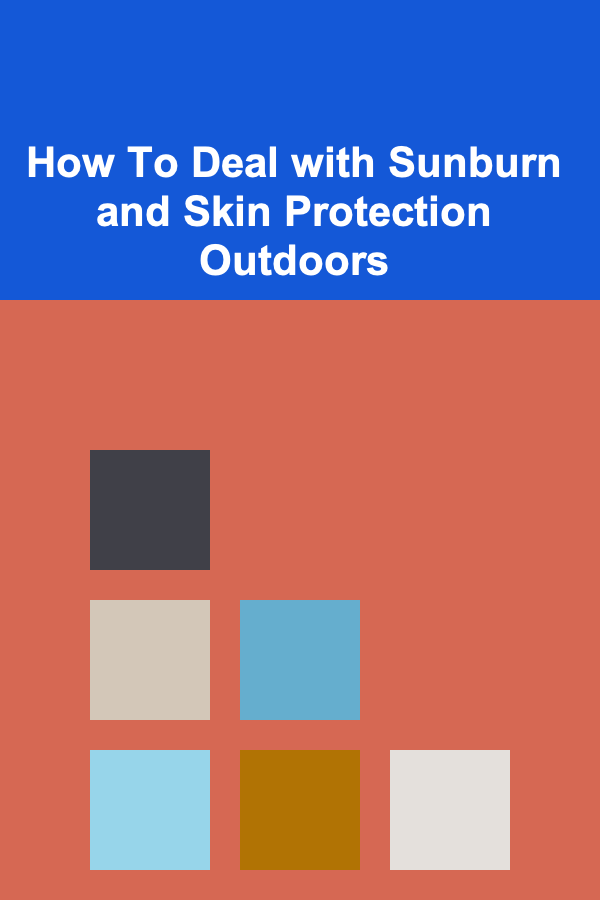
How To Deal with Sunburn and Skin Protection Outdoors
ebook include PDF & Audio bundle (Micro Guide)
$12.99$7.99
Limited Time Offer! Order within the next:

Sun exposure is a natural part of our daily lives, whether we are relaxing outdoors, exercising, or going about our daily routines. While sunlight is vital for our well-being, especially in its role in helping our bodies produce vitamin D, excessive or unprotected sun exposure can lead to harmful consequences, such as sunburn, skin damage, and even an increased risk of skin cancer. Understanding how to deal with sunburn and effectively protect your skin when spending time outdoors is essential for long-term skin health and overall well-being.
This article will explore the mechanisms of sunburn, its impact on skin, and practical tips on how to prevent it, how to treat it, and how to ensure your skin stays healthy when exposed to the sun.
Understanding Sunburn
Sunburn occurs when the skin is overexposed to ultraviolet (UV) radiation, a form of electromagnetic radiation emitted by the sun. UV radiation consists of two types: UVA and UVB rays. While both types contribute to skin damage, they affect the skin in different ways:
- UVA rays penetrate deeper into the skin and are responsible for premature aging, wrinkles, and the formation of sunspots. They also contribute to the development of certain types of skin cancer.
- UVB rays are primarily responsible for sunburns. These rays damage the outer layer of the skin, causing inflammation and redness.
When the skin is exposed to excessive UV radiation, it triggers an inflammatory response in the body, leading to the redness, pain, and swelling typically associated with sunburn. The skin cells are damaged, and in response, the body produces additional blood flow to the area to repair the damage, leading to the familiar redness.
The Dangers of Sunburn
While a mild sunburn might seem like an inconvenience, repeated or severe sunburns can have long-lasting consequences on your skin and health:
- Premature Aging: Chronic sun exposure leads to photoaging, characterized by wrinkles, sagging skin, and age spots. UV rays break down the collagen and elastin fibers in the skin, which are responsible for maintaining its structure and elasticity.
- Skin Cancer: Over time, the DNA in skin cells can be damaged by UV radiation, leading to mutations that may result in skin cancer, including basal cell carcinoma, squamous cell carcinoma, and the more dangerous melanoma. A history of severe sunburns, especially in childhood, significantly increases the risk of developing skin cancer later in life.
- Blistering and Scarring: Severe sunburns, especially those that cause blistering, can lead to permanent scarring and damage to the skin's texture. These burns often take longer to heal and can result in pigmentation issues, such as dark or light spots.
- Heatstroke and Dehydration: Prolonged exposure to the sun without adequate hydration or protection can also lead to heatstroke, dehydration, and other heat-related illnesses, further complicating the effects of sunburn.
Preventing Sunburn: Protection Strategies
The key to managing sunburn is prevention. By understanding how to protect your skin effectively, you can enjoy the outdoors while minimizing the risk of damage. Here are some practical tips on how to protect your skin from harmful UV radiation:
1. Apply Sunscreen Regularly
Sunscreen is one of the most effective tools for preventing sunburn and skin damage. The active ingredients in sunscreen absorb or reflect UV radiation before it can penetrate the skin. Here's how to choose and use sunscreen properly:
- Broad-Spectrum Protection: Select a sunscreen labeled as "broad-spectrum," which means it protects against both UVA and UVB rays.
- Sun Protection Factor (SPF): The SPF rating indicates the level of protection a sunscreen offers. A higher SPF means more protection. For everyday use, an SPF of 30 or higher is recommended. For prolonged outdoor activities, you may want to opt for an SPF of 50 or higher.
- Water-Resistant Formula: If you're swimming or sweating, choose a water-resistant sunscreen to ensure long-lasting protection.
- Reapply Often: Sunscreen wears off after a few hours, especially after swimming or sweating. Reapply every two hours and immediately after swimming or towel-drying.
- Use Generously: Apply sunscreen to all exposed skin, including areas like the ears, back of the neck, and feet, which are often overlooked.
2. Seek Shade When Possible
Whenever possible, try to stay in the shade during peak sunlight hours. The sun's rays are strongest between 10 a.m. and 4 p.m., so it's advisable to minimize direct exposure during these times. If you can't avoid being outside, try to find natural shade under trees, or bring along a wide-brimmed hat or portable umbrella to provide shade.
3. Wear Protective Clothing
Clothing can act as a physical barrier between your skin and the sun. When selecting clothes for outdoor activities, opt for materials that provide adequate UV protection:
- UPF Clothing: Look for garments labeled with an ultraviolet protection factor (UPF) rating. These clothes are specifically designed to block UV radiation and provide an extra layer of protection.
- Lightweight, Long-Sleeved Shirts and Pants: Loose-fitting, long-sleeved shirts and pants provide more coverage, reducing the amount of exposed skin. Fabrics like cotton and linen are breathable and comfortable for warm weather.
- Hats and Sunglasses: A wide-brimmed hat can protect your face, ears, and neck, while sunglasses with UV protection will shield your eyes from harmful rays.
4. Use Lip Balm with SPF
Don't forget to protect your lips, which are vulnerable to sunburn. Use a lip balm that contains SPF 15 or higher. Apply it generously before going outdoors and reapply as needed.
5. Stay Hydrated
Sun exposure can lead to dehydration, so it's essential to drink plenty of water throughout the day. Hydrated skin is better equipped to handle the effects of UV radiation and recover from sun exposure. Carry a water bottle with you when you're outside and drink regularly, especially in hot weather.
6. Be Cautious Around Reflective Surfaces
Certain surfaces, like sand, water, and snow, can reflect UV rays and increase your exposure. If you're at the beach, near a pool, or on snow-covered terrain, take extra precautions to protect your skin, as these surfaces can intensify the sun's effects.
Dealing with Sunburn: Treatment and Aftercare
Despite our best efforts to prevent sunburn, it can still happen. When you do get sunburned, it's important to treat the affected skin properly to minimize pain and facilitate healing. Here's how to take care of sunburned skin:
1. Cool Down Your Skin
The first step in treating sunburn is to cool the skin. Avoid using ice or very cold water, as this can cause further irritation. Instead, take a lukewarm or cool shower to help reduce the heat. You can also apply cold, damp compresses to the sunburned areas for relief.
2. Hydrate Your Skin
Sunburn can cause your skin to become dry and dehydrated. After cooling the skin, apply a moisturizer to lock in moisture and soothe irritation. Look for products that contain ingredients like aloe vera, chamomile, or calendula, which have anti-inflammatory and cooling properties. Avoid lotions with alcohol or fragrances, as they can further irritate the skin.
3. Avoid Scratching or Peeling
As the skin begins to heal, you may notice peeling. While this is a natural part of the healing process, avoid picking at the skin, as this can cause scarring or infection. Let the skin peel off naturally and continue moisturizing to keep it hydrated.
4. Take Anti-Inflammatory Medications
If you experience significant pain or swelling, over-the-counter anti-inflammatory medications like ibuprofen or aspirin can help reduce inflammation and alleviate discomfort. Be sure to follow the dosage instructions on the label.
5. Stay Out of the Sun
Once you've been sunburned, it's important to avoid further sun exposure until your skin has healed completely. If you must go outside, cover the sunburned areas with clothing or use a sunscreen with a high SPF.
6. Consult a Doctor for Severe Burns
In cases of severe sunburn, which may involve blistering or intense pain, it's important to seek medical advice. Blistering sunburns are more serious and can lead to complications such as infection or long-term scarring. A doctor may recommend topical treatments, pain relievers, or other interventions to help speed up the healing process.
Long-Term Skin Health and Sun Protection
While sunburn treatment focuses on immediate relief, long-term skin protection and maintenance are just as important for overall skin health. By taking consistent steps to protect your skin from the sun and maintaining good skincare habits, you can minimize the long-term risks associated with sun exposure.
1. Regular Skin Checks
Perform regular skin checks to monitor for any unusual changes, such as new moles or growths, or changes in existing moles. Skin cancer is often detectable in its early stages, so being vigilant about your skin's condition can lead to early detection and better outcomes.
2. Adopt a Healthy Skincare Routine
Use products that promote skin health and repair, such as gentle cleansers, moisturizers, and serums that contain antioxidants. Vitamin C, for example, helps repair skin damage caused by UV exposure and supports the production of collagen.
3. Consider Professional Treatments
If you've had significant sun exposure over the years, you may want to consider treatments like chemical peels, microdermabrasion, or laser therapy to reduce the appearance of sunspots, wrinkles, and other signs of sun damage. Always consult with a dermatologist to determine the best course of action.
Conclusion
Sunburn is a painful and harmful consequence of excessive sun exposure, but it can be prevented and managed with proper precautions. By understanding how to protect your skin from harmful UV radiation and how to treat sunburn when it occurs, you can reduce the risk of long-term skin damage and maintain healthy, beautiful skin for years to come. Always remember that consistent protection is key, and taking the time to care for your skin will pay off in the long run.
Reading More From Our Other Websites
- [Personal Investment 101] How to Use Bonds for Stable Income in Your Portfolio
- [Personal Care Tips 101] How to Read and Understand Ingredient Labels
- [Home Budget 101] How to Manage a Variable Income and Maintain a Stable Home Budget: Tips for Freelancers and Entrepreneurs
- [Home Staging 101] How to Stage a Vacant Home on a Budget
- [Trail Running Tip 101] Boosting Leg and Core Power: Trail Running Workouts for a Stronger Body
- [Home Cleaning 101] How to Clean Your Home with Minimal Products and Maximum Results
- [Home Soundproofing 101] How to Use Rockwool for Effective Soundproofing in Your Home
- [Rock Climbing Tip 101] Top-Rope Climbing Gear Guide: What You Need for a Successful Session
- [Home Maintenance 101] How to Protect Your Home's Exterior from Extreme Weather Conditions
- [Personal Care Tips 101] How to Use Lip Liner for a Flawless Lipstick Application

How to Create a Seasonal Decor Rotation for Your Family Room
Read More
How to Maximize Your Tax Deductions and Minimize Tax Liability
Read More
How to Price Your Health and Nutrition Consulting Services
Read More
How To Use the Premeditation of Evils for Preparedness
Read More
How to Hand Letter Holiday Cards with Foil
Read More
10 Tips for Using Python for Statistical Analysis
Read MoreOther Products

How to Create a Seasonal Decor Rotation for Your Family Room
Read More
How to Maximize Your Tax Deductions and Minimize Tax Liability
Read More
How to Price Your Health and Nutrition Consulting Services
Read More
How To Use the Premeditation of Evils for Preparedness
Read More
How to Hand Letter Holiday Cards with Foil
Read More